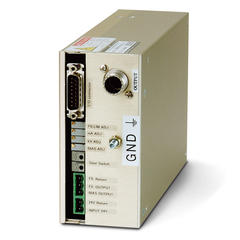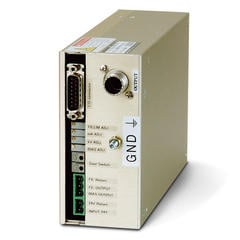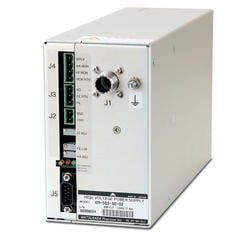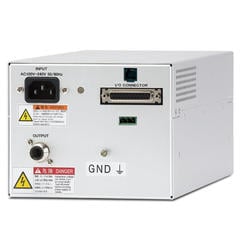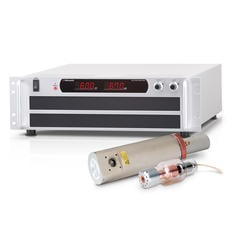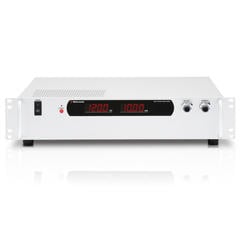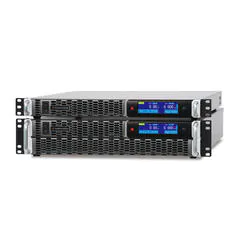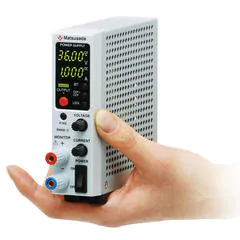X-ray tubes come in a variety of shapes and sizes to suit different applications, and there are also a variety of high-voltage power supplies and control circuits to use them. This section describes the various types of X-ray tubes and three types of high-voltage circuits: simple X-ray tubes, X-ray tubes with a Be window, rotating anode X-ray tubes, ceramic X-ray tubes, end-window X-ray tubes, X-ray tubes for X-ray diffractometers, microfocus X-ray tubes, and open X-ray tubes (transmission target X-ray tubes and reflection target X-ray tubes). Three types of high-voltage circuits will be discussed: anode-grounded, cathode-grounded, and bipolar.
Simple X-ray tube
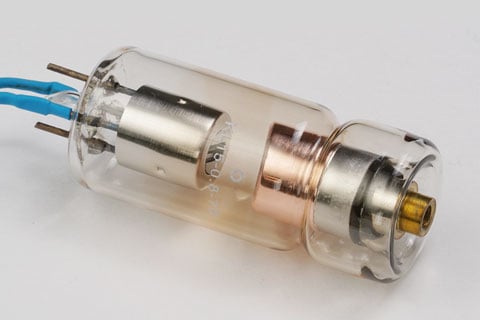
A simple X-ray tube consists of a filament (cathode), which generates thermal electrons, and an anode, which generates X-rays when electrons collide, fixed in a glass tube and vacuumed. Many of these tubes are relatively small, and are used at voltages ranging from 20 kV to 130 kV. They are used for non-destructive inspection using X-rays, foreign object inspection, analysis and medical applications. They are usually placed in a special metal case (housing for X-ray tubes) filled with insulating oil to reduce X-ray leakage and make them safe and easy to handle. In some cases, the surface is covered with resin or other material. In non-destructive testing of infrastructure, etc., X-ray shield cases filled with insulating gas are used instead of insulating oil to reduce the weight of the X-ray unit. The high-voltage power supply can be connected to anode grounding, cathode grounding, or bipolar.
Beryllium-Window X-Ray Tube
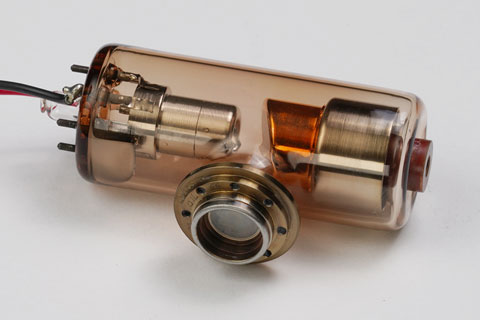
A Beryllium-Window X-Ray Tube is an X-ray tube with beryllium (element symbol Be, atomic number 4) attached to the output portion of the X-ray. X-ray tube voltage ranges from a few kilovolts to 80 kV, and is mainly used for X-ray analysis. They are expensive than ordinary X-ray tubes.
Rotating anode X-ray tube
A rotating anode X-ray tube is an X-ray tube in which the anode, which generates X-rays when hit by an electron beam, rotates. By rotating the anode, heat can be dispersed, and the tube current can be increased to increase the intensity of X-rays. It is mainly used in medical applications such as CT scans and X-ray imaging. Due to its complicated structure, it is a very expensive X-ray tube.
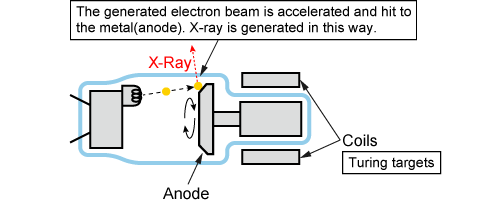
Ceramic X-ray tube
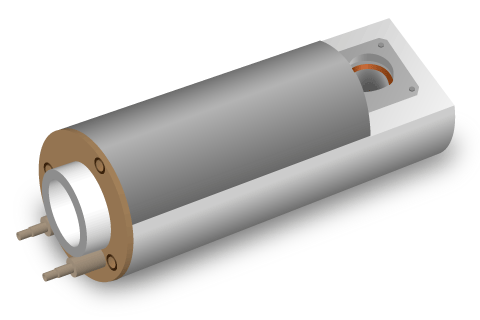
A ceramic X-ray tube is a vacuum tube in which the insulating part of the X-ray tube is made of ceramics instead of glass. They are resistant to heat and shock and are mainly used for non-destructive testing and XRD. Other small X-ray tubes made of ceramics are also used in handheld X-ray fluorescence analyzers and soft X-ray ionization tubes.
End-window X-ray tube (X-ray tube for XRF)
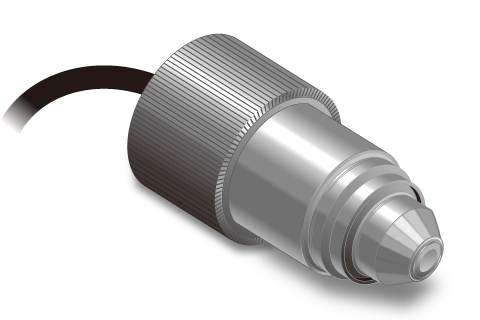
An end-window X-ray tube is an X-ray tube in which the beryllium window is located at the end face of the X-ray tube. Since the anode, which generates X-rays, is located near the end of the beryllium window, the distance to the analysis sample can be shortened and more X-rays can be emitted. The power supply for X-ray tubes is a cathode-grounded high-voltage power supply, with tube voltages ranging from 50 kV to 80 kV and power from 50 W to 4 kW.
X-ray tubes for X-ray diffractometers(XRD X-ray Tubes)
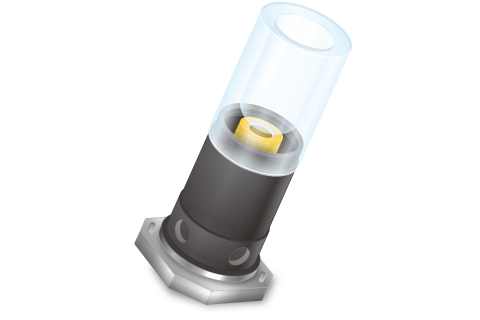
X-ray tubes for XRD are X-ray tubes used in X-ray diffractometers (XRD), which are designed to be easily interchangeable since different target materials are used depending on the analysis target. X-ray tubes for XRD are sold by various companies, and they are highly interchangeable and can be used by different manufacturers. However, it is important to note that there are two types: short anode and long anode. There are also glass and ceramic tube types available on the market. The voltage can be up to 60kV, but the power of the X-ray tube is large, ranging from 1kW to 4kW, and water cooling is required. X-ray tubes for XRD are anode-grounded type.
- Manufacturers
- Philips/Panalytical: https://www.malvernpanalytical.com/en/products/category/x-ray-tubes/xrdtubes
- Siemens/Bruker: https://www.bruker.com/en/products-and-solutions/diffractometers-and-x-ray-microscopes/x-ray-diffractometers/davinci-components/sources.html
- PROTO: https://www.protoxrd.com/products/x-ray-tubes/overview
- AXT Pty Ltd (AXT): https://www.axtxraytubes.com/ceramic-xrd-tubes/
Microfocus X-ray tubes
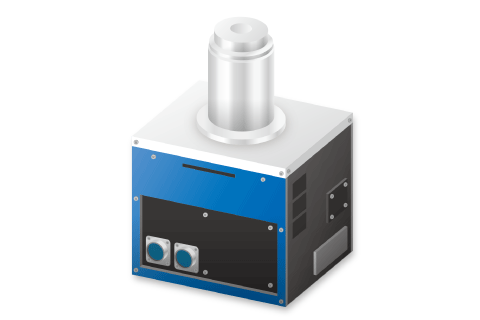
A microfocus X-ray tube is an X-ray tube in which the X-ray emitting area is very small, ranging from a few micrometers to several tens of micrometers. In a microfocus X-ray tube, electrons generated from the filament are converged and hit the anode (target) to generate X-rays. The area where X-rays are generated is called the focal point, and by reducing the size of the focal point to the micrometer size, sharp X-ray images with little blur can be obtained even when X-ray images are magnified. For this reason, microfocus X-ray tubes are used for non-destructive inspection of electronic devices with fine structures.
Microfocus X-ray tubes require multiple electrodes in addition to a high-voltage power supply for acceleration in order to focus the electrons. Acceleration voltages of 90kV to 150kV are used. There are two types of microfocus X-ray tubes: open X-ray tubes and sealed microfocus X-ray tubes.
Open type X-ray tubes (transmission target X-ray tubes and reflection target X-ray tubes)
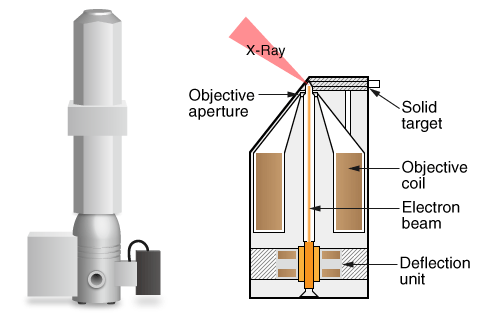
An open-type X-ray tube is an X-ray tube in which the filament and target can be replaced, and the inside of the X-ray tube is evacuated with a vacuum pump to create a vacuum. Most open-type X-ray tubes have a micro-focus or nano-focus size focal diameter, which allows them to capture images of small parts with minimal blur even when they are magnified. There are two types of open-type X-ray tubes: transmission target type and reflection target type. The reflective target type uses the X-rays generated on the incident side of the electrons, just like a normal X-ray tube. On the other hand, the transmissive target type open microfocus X-ray tube uses a target material such as tungsten deposited on a beryllium window or diamond window. When electrons are incident on the tungsten target, X-rays are emitted in all directions of 360 degrees. In a reflective X-ray tube, the X-rays emitted in the back of the target are very small because the target is thick. In a transmissive target X-ray tube, the tungsten target is thin, and the base material (window material) is beryllium or diamond, so many X-rays are emitted from the backside. The transmission target type microfocus X-ray tube utilizes these X-rays. With a transmission target, the distance between the X-ray focal point (X-ray generation point) and the sample can be made very short, allowing for a large magnification. However, due to the thermal capacity of the target, the target current cannot be increased. Open X-ray tubes are commercially available with acceleration voltages ranging from 100 kV to 300 kV.
Three types of high-voltage circuits
Anode grounding connection
The anode ground connection is an easy way to dissipate heat because the anode of the X-ray tube, which generates a lot of heat, can be grounded. As for the power supply, a high-voltage power supply with negative output is connected to the cathode side, but the power supply for the filament floating on top of that potential is also required. This connection method is applicable to X-ray tubes for XRD, open-type microfocus X-ray tubes, ceramic X-ray tubes, etc.
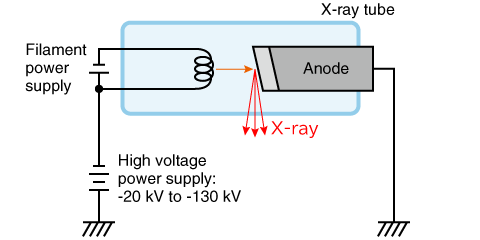
Cathode grounding connection
In the cathode-ground connection, one of the filaments of the X-ray tube is connected to ground potential, and a positive output high-voltage power supply is connected to the anode side. The X-ray tube current is controlled by the filament current, which determines its temperature and the number of electrons emitted. This connection method is applicable to sealed microfocus X-ray and end-window type XRF X-ray tubes. For high-power XRF X-ray tubes, water cooling with pure water is used to cool the anode.
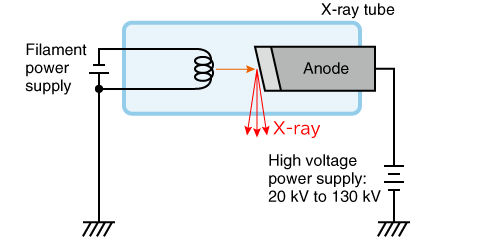
Bipolar connection
In the bipolar connection, a negative output high-voltage power supply is connected to the cathode of the X-ray tube, and a positive output high-voltage power supply is connected to the anode. This connection is used when the accelerating voltage (tube voltage) of X-rays needs to be increased. For example, if a 320kV tube voltage is required, connect a -160kV high voltage power supply to the cathode side and a +160kV power supply to the anode side.
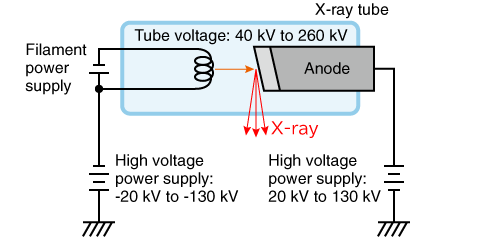
Related Technical Articles
- What is the difference between radioactivity, radiation, and radioactive materials?
- Understanding Radiation: Effects on the Body and X-ray Safety
- FAQ: What is the tube voltage or acceleration voltage necessary for X-ray inspection systems?
- How to use X-ray Inspection System safely
- How to Acquire High-Quality Computed Tomography (CT) Images - X-ray NDT series (1)
Recommended products
Matsusada Precision provides solutions for X-ray applications with X-ray generation and X-ray tube power supply.



